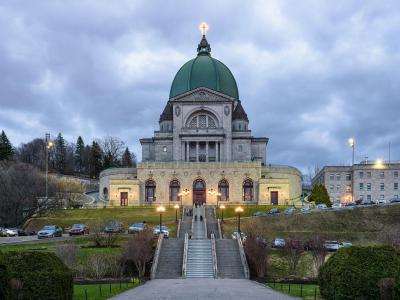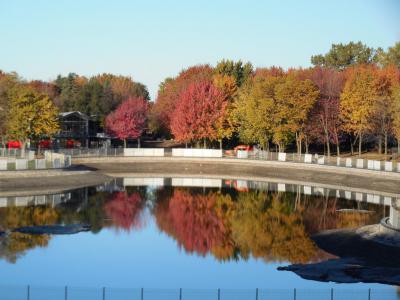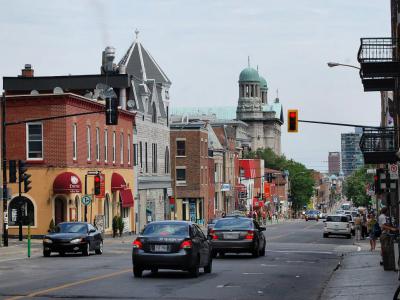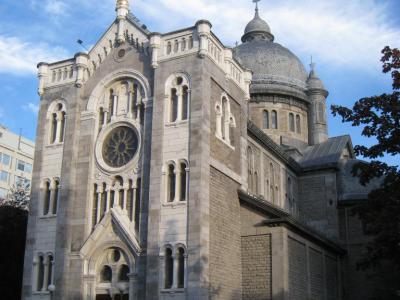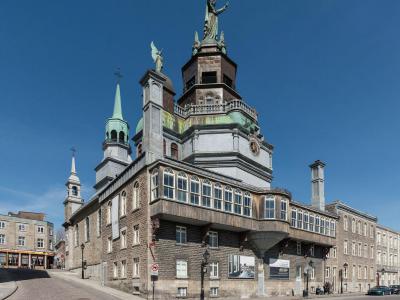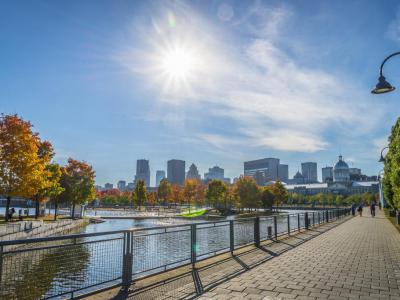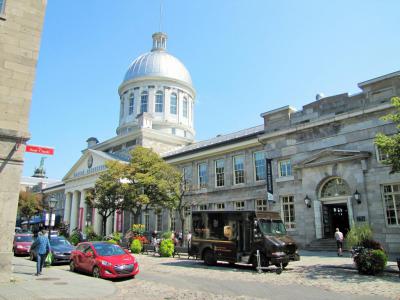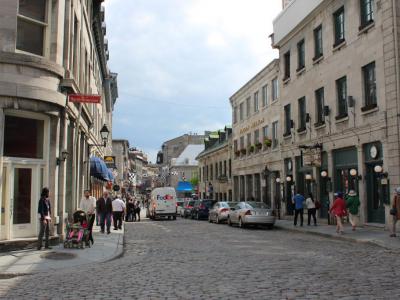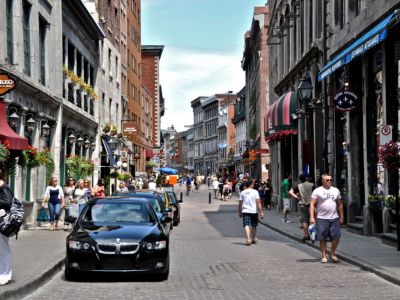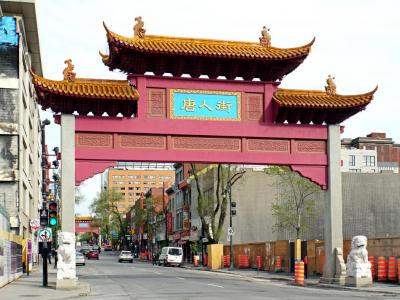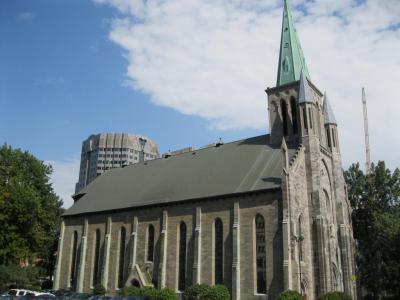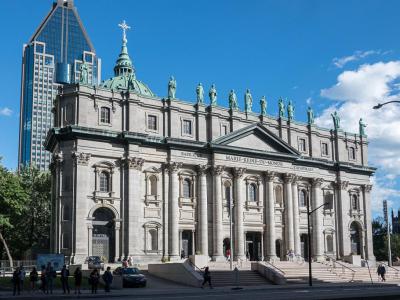Custom Walk in Montreal, Canada by alannageorge_bc242 created on 2025-05-08
Guide Location: Canada » Montreal
Guide Type: Custom Walk
# of Sights: 13
Tour Duration: 7 Hour(s)
Travel Distance: 16.1 Km or 10 Miles
Share Key: F9QH3
Guide Type: Custom Walk
# of Sights: 13
Tour Duration: 7 Hour(s)
Travel Distance: 16.1 Km or 10 Miles
Share Key: F9QH3
How It Works
Please retrieve this walk in the GPSmyCity app. Once done, the app will guide you from one tour stop to the next as if you had a personal tour guide. If you created the walk on this website or come to the page via a link, please follow the instructions below to retrieve the walk in the app.
Retrieve This Walk in App
Step 1. Download the app "GPSmyCity: Walks in 1K+ Cities" on Apple App Store or Google Play Store.
Step 2. In the GPSmyCity app, download(or launch) the guide "Montreal Map and Walking Tours".
Step 3. Tap the menu button located at upper right corner of the "Walks" screen and select "Retrieve custom walk". Enter the share key: F9QH3
1) Saint Joseph's Oratory of Mount-Royal (must see)
Saint Joseph's Oratory of Mount Royal is a Roman Catholic minor basilica and national shrine situated on Queen Mary Road in Montreal, Quebec's Côte-des-Neiges neighborhood. It holds the distinction of being Canada's largest church and is designated as a National Historic Site of Canada. The oratory's location on Mount Royal's Westmount Summit grants it prominence, with its towering height and one of the world's largest church domes.
Saint André Bessette established the Oratory in 1904 as a tribute to his patron saint, Saint Joseph. Over the course of six decades, countless architects and workers contributed to its creation. The Oratory's grandeur, featuring a Renaissance Revival facade and an Art Deco interior, has made it an iconic landmark globally, drawing more than 2 million visitors and pilgrims annually.
Remarkably, the Oratory is Montreal's tallest structure, rising over 30 meters above the summit of Mount Royal, making it visible from several kilometers away. It stands out for its defiance of the height restrictions outlined in the municipal building code of Montreal, which generally prohibits structures, including skyscrapers, from surpassing the mountain's elevation.
Since 2018, extensive renovations have been underway on the Oratory's dome and lantern, with completion expected in 2024. The esteemed architecture firms Atelier TAG and Architecture49 have undertaken this project. Once finished, it will provide secure access to the lantern, affording an unparalleled 360-degree view of the city and the mountain.
Why You Should Visit:
Enormous upper church and lower crypt church. Accessible by either stairs or escalators/elevators. Terraces have outstanding views looking down on Montreal. Awe-inspiring.
Tip:
Free pipe organ concerts with organists from around the world on Sunday afternoons!
Saint André Bessette established the Oratory in 1904 as a tribute to his patron saint, Saint Joseph. Over the course of six decades, countless architects and workers contributed to its creation. The Oratory's grandeur, featuring a Renaissance Revival facade and an Art Deco interior, has made it an iconic landmark globally, drawing more than 2 million visitors and pilgrims annually.
Remarkably, the Oratory is Montreal's tallest structure, rising over 30 meters above the summit of Mount Royal, making it visible from several kilometers away. It stands out for its defiance of the height restrictions outlined in the municipal building code of Montreal, which generally prohibits structures, including skyscrapers, from surpassing the mountain's elevation.
Since 2018, extensive renovations have been underway on the Oratory's dome and lantern, with completion expected in 2024. The esteemed architecture firms Atelier TAG and Architecture49 have undertaken this project. Once finished, it will provide secure access to the lantern, affording an unparalleled 360-degree view of the city and the mountain.
Why You Should Visit:
Enormous upper church and lower crypt church. Accessible by either stairs or escalators/elevators. Terraces have outstanding views looking down on Montreal. Awe-inspiring.
Tip:
Free pipe organ concerts with organists from around the world on Sunday afternoons!
2) Mount Royal Park (must see)
Mount Royal Park was opened in 1876. Fredrick Law Olmsted, a famous landscape architect designed this park. It is now one of the largest green spaces in Montreal that attracts more than 5 million visitors every year. If you are a passionate outdoor enthusiast, you will definitely enjoy the wide variety of plants and birds in this park. It also offers plenty of outdoor activities for all ages in all seasons.
Mount Royal Park offers some of the most mesmerizing skyline views of the city. Summit Park is a must-see spot in this park. You can see some rare wild plants here. The Georges Etienne Cartier monument is another important attraction that draws crowds. In recent times, the monument is the site for the popular TamTam’s festivities. The Beaver Lake in Mount Royal Park is an ideal picnic spot for locals and tourists.
Mount Royal Park also houses the Smith House, which is a major spot for those who want to obtain historical information about the park and the city. Mount Royal Cemetery is a pleasant place if you want to enjoy a relaxed walking or biking. It is a perfect place for picnicking too. The cemetery is more attractive in May when flowering trees bloom.
Why You Should Visit:
Great panoramic view of Montreal and the large area allows winter activities like cross-country skiing while summer and fall make a great place to hike, jog or walk.
Tip:
It takes about 20 to 30 minutes to get to the top of Mount Royal once you have reached the park. There is a gravel trail (mainly for bikes) and also a wooden staircase (for walkers) to the top. There is at least one lower vantage point that might make you think you're done, but keep going till you get to 'The Chalet'.
Mount Royal Park offers some of the most mesmerizing skyline views of the city. Summit Park is a must-see spot in this park. You can see some rare wild plants here. The Georges Etienne Cartier monument is another important attraction that draws crowds. In recent times, the monument is the site for the popular TamTam’s festivities. The Beaver Lake in Mount Royal Park is an ideal picnic spot for locals and tourists.
Mount Royal Park also houses the Smith House, which is a major spot for those who want to obtain historical information about the park and the city. Mount Royal Cemetery is a pleasant place if you want to enjoy a relaxed walking or biking. It is a perfect place for picnicking too. The cemetery is more attractive in May when flowering trees bloom.
Why You Should Visit:
Great panoramic view of Montreal and the large area allows winter activities like cross-country skiing while summer and fall make a great place to hike, jog or walk.
Tip:
It takes about 20 to 30 minutes to get to the top of Mount Royal once you have reached the park. There is a gravel trail (mainly for bikes) and also a wooden staircase (for walkers) to the top. There is at least one lower vantage point that might make you think you're done, but keep going till you get to 'The Chalet'.
3) Plateau Mont-Royal (must see)
Situated east of Mont-Royal and north of downtown, Plateau Mont-Royal is a must-see destination when visiting Montreal. Its name stems from its location on the flat terrain of Sherbrooke Street.
Historically, the western part of the Plateau was inhabited by Jews, while the eastern part was predominantly occupied by Quebecois. It was primarily a working-class neighborhood and served as the residence for renowned Quebec writers like Mordecai Richler and Michel Tremblay. Their literary works often featured the Plateau during the 1950s and 1960s.
Prepare to be pleasantly enchanted by the lively ambiance of Plateau Mont-Royal, characterized by vibrant, colorful houses, cozy bookstores, delightful cafes, and a friendly demeanor. Don't miss the chance to explore popular attractions along Saint Laurent Boulevard.
A visit to Schwartz's Deli is a must to experience the origins of the delectable Montreal smoked meat. If you're there in the summer, you can immerse yourself in the bustling street fair that takes place on weekends. This neighborhood emanates a bohemian atmosphere and benefits from its proximity to the esteemed McGill University, which has attracted many residents to settle here.
Presently, the Saint-Denis and Saint-Laurent strip is lined with an array of nightclubs, upscale restaurants, and exclusive fashion stores, offering a diverse range of entertainment options.
Why You Should Visit:
This part of town has a unique architecture with many wrought iron staircases outside the homes. Really elegant area and a great place to walk.
It's worth a trip just to visit Parc de La Fontaine during the summer or fall.
Tip:
Nightlife is good: make sure you go by Saint Denis or Saint Laurent streets.
Historically, the western part of the Plateau was inhabited by Jews, while the eastern part was predominantly occupied by Quebecois. It was primarily a working-class neighborhood and served as the residence for renowned Quebec writers like Mordecai Richler and Michel Tremblay. Their literary works often featured the Plateau during the 1950s and 1960s.
Prepare to be pleasantly enchanted by the lively ambiance of Plateau Mont-Royal, characterized by vibrant, colorful houses, cozy bookstores, delightful cafes, and a friendly demeanor. Don't miss the chance to explore popular attractions along Saint Laurent Boulevard.
A visit to Schwartz's Deli is a must to experience the origins of the delectable Montreal smoked meat. If you're there in the summer, you can immerse yourself in the bustling street fair that takes place on weekends. This neighborhood emanates a bohemian atmosphere and benefits from its proximity to the esteemed McGill University, which has attracted many residents to settle here.
Presently, the Saint-Denis and Saint-Laurent strip is lined with an array of nightclubs, upscale restaurants, and exclusive fashion stores, offering a diverse range of entertainment options.
Why You Should Visit:
This part of town has a unique architecture with many wrought iron staircases outside the homes. Really elegant area and a great place to walk.
It's worth a trip just to visit Parc de La Fontaine during the summer or fall.
Tip:
Nightlife is good: make sure you go by Saint Denis or Saint Laurent streets.
4) Our Lady of Lourdes Chapel (Notre-Dame-de-Lourdes)
Our Lady of Lourdes Chapel, also known as Notre-Dame-de-Lourdes, is a magnificent religious landmark located in downtown Montreal. The chapel holds a special place in the heart of its creator, Napoléon Bourassa (1827-1916), an artist-apostle who poured his love and devotion into every aspect of its design and construction.
The Chapel of Our Lady of Lourdes is built in the Romano-Byzantine style. Its interior decoration guides the eye to the center of the dome, which portrays the proclamation of the dogma of the Immaculate Conception. This architectural masterpiece surpasses previous religious art in Canada.
On April 30, 1881, the Chapel of Our Lady of Lourdes was opened for worship. Since then, it has become a place of pilgrimage and a sanctuary of prayer and peace. The chapel offers a serene refuge where the Virgin Mary welcomes pilgrims from across Quebec and beyond.
Entering the chapel, one is mesmerized by its architectural beauty. The single nave showcases a barrel vault supported by gray marble pilasters with engaged columns. Transverse arches add support and a touch of grandeur. Trefoil windows bring in ample natural light, illuminating the detailed decoration that harmoniously follows a Mariological theme.
The colors used throughout the chapel blend together harmoniously, culminating in the hemisphere of the dome, which is supported by four pendentives. Each pendentive showcases a painted angel, seemingly in contemplation of their Queen. At the apex of the dome, against a backdrop of stars and cherubim, stands the figure of Mary, the focal point of devotion and reverence.
The Chapel of Our Lady of Lourdes is built in the Romano-Byzantine style. Its interior decoration guides the eye to the center of the dome, which portrays the proclamation of the dogma of the Immaculate Conception. This architectural masterpiece surpasses previous religious art in Canada.
On April 30, 1881, the Chapel of Our Lady of Lourdes was opened for worship. Since then, it has become a place of pilgrimage and a sanctuary of prayer and peace. The chapel offers a serene refuge where the Virgin Mary welcomes pilgrims from across Quebec and beyond.
Entering the chapel, one is mesmerized by its architectural beauty. The single nave showcases a barrel vault supported by gray marble pilasters with engaged columns. Transverse arches add support and a touch of grandeur. Trefoil windows bring in ample natural light, illuminating the detailed decoration that harmoniously follows a Mariological theme.
The colors used throughout the chapel blend together harmoniously, culminating in the hemisphere of the dome, which is supported by four pendentives. Each pendentive showcases a painted angel, seemingly in contemplation of their Queen. At the apex of the dome, against a backdrop of stars and cherubim, stands the figure of Mary, the focal point of devotion and reverence.
5) Chapel of Our Lady of Good Help (Chapelle Notre-Dame-de-Bon-Secours)
The Chapel of Our Lady of Good Help (Notre-Dame-de-Bon-Secours) was built in 1771 as the first pilgrimage site in the Old Port of Montreal for the arrived sailors who wished to make offerings to the Virgin in gratitude for her "good help" in a safe voyage across the Atlantic. It is also the oldest surviving chapel in the Old City.
The church sits directly on top of an older temple – of 1675 – that was destroyed by fire. The foundations of the first church, uncovered recently during excavations in the crypt underneath the chapel, provide insight into the times long gone. Among other things, this archaeological site contains artifacts from the First Nations and French colonial periods, including fragments of the colony's early fortifications. Those interested in history can take a guided audio tour of the underground crypt and learn more about the early days of Montreal and the chapel site.
Emphasizing its connection with the maritime theme, the chapel is also often referred to as the Sailors' Church. In line with its nautical flair, the interior décor – simple yet elegant – is definitely worth a peek, if only to observe the gorgeous ship replicas hanging from the ceiling.
Visitors to the church can also climb the wooden stairs and explore the building's prominent spire. From up there opens a spectacular view of the harbour, the Saint Lawrence River, the Old Port, the remnants of Expo 67, and Our Lady of the Harbour statue – immortalized in the Leonard Cohen song 'Suzanne' ("And the sun pours down like honey / On our lady of the harbour"). And, of course, you can see up close the angels on the chapel roof, too.
The church also houses the Marguerite Bourgeoys Museum, dedicated to the life of Saint Marguerite Bourgeoys, founder of the Notre-Dame congregation. In 2005, her mortal remains were brought back to the temple and interred in the sanctuary.
The church sits directly on top of an older temple – of 1675 – that was destroyed by fire. The foundations of the first church, uncovered recently during excavations in the crypt underneath the chapel, provide insight into the times long gone. Among other things, this archaeological site contains artifacts from the First Nations and French colonial periods, including fragments of the colony's early fortifications. Those interested in history can take a guided audio tour of the underground crypt and learn more about the early days of Montreal and the chapel site.
Emphasizing its connection with the maritime theme, the chapel is also often referred to as the Sailors' Church. In line with its nautical flair, the interior décor – simple yet elegant – is definitely worth a peek, if only to observe the gorgeous ship replicas hanging from the ceiling.
Visitors to the church can also climb the wooden stairs and explore the building's prominent spire. From up there opens a spectacular view of the harbour, the Saint Lawrence River, the Old Port, the remnants of Expo 67, and Our Lady of the Harbour statue – immortalized in the Leonard Cohen song 'Suzanne' ("And the sun pours down like honey / On our lady of the harbour"). And, of course, you can see up close the angels on the chapel roof, too.
The church also houses the Marguerite Bourgeoys Museum, dedicated to the life of Saint Marguerite Bourgeoys, founder of the Notre-Dame congregation. In 2005, her mortal remains were brought back to the temple and interred in the sanctuary.
6) Old Port (Vieux-Port) (must see)
Located on the north bank of the Saint Lawrence River, the historic Old Port of Montreal (Vieux-Port de Montréal) stretches for over two kilometers (1.2 miles) south of Old Montreal, in a natural harbor that was once frequented by Amerindian canoes and then by barges and ships of French fur traders and others.
In service from as early as 1611, the port bore witness to the economic and cultural development of Montreal and remained in use until 1976, when the present Port of Montreal was launched further east. In the early 1990s, the territory was redeveloped and in 2005 changed its name to The Quays of the Old Port of Montreal. Today, it serves as a recreational and historical area, attracting annually over six million visitors.
A place for all seasons, there's always something happening here! Summer is great for all sorts of riverfront activities such as rollerblading, cycling, quadricycling, and pleasure boating. Taking a boat cruise on the Saint Lawrence river, or renting a pedal boat for a trip around Bonsecours Basin is also available. A thin park, running the entire length of the Old Port Promenade, offers tourists and locals an ideal spot to relax and catch a cool breeze off the water.
Winter is ideal for skating on the outdoor rink or just playing in the snow. At all times of the year, the Saint Lawrence river is awe-inspiring and powerful.
The on-site attractions include a "labyrinth" in Shed 16 (which is a maze of alleys and obstacles built inside an old waterfront warehouse), the Montreal Science Centre (complete with an IMAX Theatre) on King Edward Pier, and the Montreal Clock Tower.
One of the Port's gems is the Montreal-based Cirque du Soleil which approximately every two years, in spring, launches a new show from the Jacques Cartier Quay by setting up its signature blue-and-yellow-striped tents. In June 2012, an urban beach, called the Clock Tower Beach (Plage de l'Horloge), was opened adjacent to the Clock Tower.
Cultural events in the area include the Montreal High Lights Festival (Festival Montréal en lumière), Igloofest, and the Matsuri Japon festival.
If you have a couple of hours to kill in Montreal, wandering around the Old Port is worth considering.
In service from as early as 1611, the port bore witness to the economic and cultural development of Montreal and remained in use until 1976, when the present Port of Montreal was launched further east. In the early 1990s, the territory was redeveloped and in 2005 changed its name to The Quays of the Old Port of Montreal. Today, it serves as a recreational and historical area, attracting annually over six million visitors.
A place for all seasons, there's always something happening here! Summer is great for all sorts of riverfront activities such as rollerblading, cycling, quadricycling, and pleasure boating. Taking a boat cruise on the Saint Lawrence river, or renting a pedal boat for a trip around Bonsecours Basin is also available. A thin park, running the entire length of the Old Port Promenade, offers tourists and locals an ideal spot to relax and catch a cool breeze off the water.
Winter is ideal for skating on the outdoor rink or just playing in the snow. At all times of the year, the Saint Lawrence river is awe-inspiring and powerful.
The on-site attractions include a "labyrinth" in Shed 16 (which is a maze of alleys and obstacles built inside an old waterfront warehouse), the Montreal Science Centre (complete with an IMAX Theatre) on King Edward Pier, and the Montreal Clock Tower.
One of the Port's gems is the Montreal-based Cirque du Soleil which approximately every two years, in spring, launches a new show from the Jacques Cartier Quay by setting up its signature blue-and-yellow-striped tents. In June 2012, an urban beach, called the Clock Tower Beach (Plage de l'Horloge), was opened adjacent to the Clock Tower.
Cultural events in the area include the Montreal High Lights Festival (Festival Montréal en lumière), Igloofest, and the Matsuri Japon festival.
If you have a couple of hours to kill in Montreal, wandering around the Old Port is worth considering.
7) Bonsecours Market (Marche Bonsecours)
Bonsecours Market (Marché Bonsecours) owes its name to the adjacent Chapel of Our Lady of Good Help (Notre-Dame-de-Bon-Secours).
Inaugurated in 1847, for over a century this was the primary agricultural market for the Montreal area. Also, for a brief period – just one session, in 1849 – the building housed the Legislative Assembly (Parliament) of United Canada and, throughout 1852-1878, accommodated the Montreal City Hall.
The elongated two-story Neoclassical edifice with a tin-plated dome and columns is considered one of the main achievements of Canadian architecture. In 1984, it was designated a National Historic Site of Canada. The design – by British architect William Footner – was influenced by Dublin's Customs House. Further additions, including a 900-square-meter concert and banquet hall, completed in 1860, were designed by Irish-born Montreal architect George Browne.
The building continued to serve as the farmer's central market, as well as a venue for banquets, exhibitions, and festivals until it was closed in 1963. After standing idle for a few years, it was slated for demolition.
Luckily, the property was later transformed into a multi-purpose facility with a mall incorporating outdoor cafés, restaurants, and exclusive boutiques selling authentic Canadian crafts such as jewelry, leather, and hand-blown glass – all made in Quebec. Those keen on maple tree products will be particularly delighted to find here a huge variety of relevant merchandise including beer, wine, butter, and even lollipops.
However, if shopping isn't your prime interest, you may just as well walk around the site and find some pretty angles to photograph the building's grand-looking exterior. Or, perhaps, grab yourself a seat in one of the cafés and restaurants lining the facade and have a good time.
Inaugurated in 1847, for over a century this was the primary agricultural market for the Montreal area. Also, for a brief period – just one session, in 1849 – the building housed the Legislative Assembly (Parliament) of United Canada and, throughout 1852-1878, accommodated the Montreal City Hall.
The elongated two-story Neoclassical edifice with a tin-plated dome and columns is considered one of the main achievements of Canadian architecture. In 1984, it was designated a National Historic Site of Canada. The design – by British architect William Footner – was influenced by Dublin's Customs House. Further additions, including a 900-square-meter concert and banquet hall, completed in 1860, were designed by Irish-born Montreal architect George Browne.
The building continued to serve as the farmer's central market, as well as a venue for banquets, exhibitions, and festivals until it was closed in 1963. After standing idle for a few years, it was slated for demolition.
Luckily, the property was later transformed into a multi-purpose facility with a mall incorporating outdoor cafés, restaurants, and exclusive boutiques selling authentic Canadian crafts such as jewelry, leather, and hand-blown glass – all made in Quebec. Those keen on maple tree products will be particularly delighted to find here a huge variety of relevant merchandise including beer, wine, butter, and even lollipops.
However, if shopping isn't your prime interest, you may just as well walk around the site and find some pretty angles to photograph the building's grand-looking exterior. Or, perhaps, grab yourself a seat in one of the cafés and restaurants lining the facade and have a good time.
8) Saint-Paul Street (Rue St-Paul) (must see)
Saint-Paul (Rue Saint-Paul) is the oldest street in Montreal, laid out in 1673 according to a plan by François Dollier de Casson. It follows the path that once bordered the northern edge of the former Fort Ville-Marie and is named after Paul de Chomedey de Maisonneuve, founder of the fort and the first governor of Montreal, who built a home for himself in this area in 1650.
Unlike other – straight – streets drawn by Dollier de Casson, the cavernous cobblestone Saint-Paul is a bit winding. Centered on Royal Square (Place Royale), a major marketplace until 1803, it was destined to become, for many years, the city's main thoroughfare. In the 19th century, Old Montreal was the cradle of the local press, making Saint Paul home to a multitude of French- and English-language newspapers and journals. Busy day and night, the street was the first in the city to benefit from oil lighting.
There are several historic buildings lining Saint-Paul such as the Intendance Palace of 1698 and the Vaudreuil Castle (Château de Vaudreuil) of 1724. The street is also home to such prominent landmarks as the Bonsecours Market and the Chapel of Our Lady of Good Help (Notre-Dame-de-Bon-Secours). It also boasts perhaps the highest in the city concentration of tourist-themed souvenir shops, art galleries, boutique hotels, lively rooftop terraces, cafés, and eateries with international cuisine.
Tip:
In case you are budget-conscious, remember that the prices in this area are a bit higher than usual.
Unlike other – straight – streets drawn by Dollier de Casson, the cavernous cobblestone Saint-Paul is a bit winding. Centered on Royal Square (Place Royale), a major marketplace until 1803, it was destined to become, for many years, the city's main thoroughfare. In the 19th century, Old Montreal was the cradle of the local press, making Saint Paul home to a multitude of French- and English-language newspapers and journals. Busy day and night, the street was the first in the city to benefit from oil lighting.
There are several historic buildings lining Saint-Paul such as the Intendance Palace of 1698 and the Vaudreuil Castle (Château de Vaudreuil) of 1724. The street is also home to such prominent landmarks as the Bonsecours Market and the Chapel of Our Lady of Good Help (Notre-Dame-de-Bon-Secours). It also boasts perhaps the highest in the city concentration of tourist-themed souvenir shops, art galleries, boutique hotels, lively rooftop terraces, cafés, and eateries with international cuisine.
Tip:
In case you are budget-conscious, remember that the prices in this area are a bit higher than usual.
9) Old Montreal (must see)
Transporting you back to the era of New France, Old Montreal stands as one of the most ancient districts frequented by tourists. Positioned ideally within Ville-Marie's borough, this neighborhood is bordered by Ruelle des Fortifications to the north, McGill Street to the west, the majestic Saint Lawrence River to the south, and Berri Street to the east.
Ville-Marie borough remains vibrant and dynamic, fueled by its perpetually lively neighborhoods, including the bustling downtown core, McGill Ghetto, Latin Quarter, Chinatown, Gay Village, and Old Montreal. Visitors revel in exploring this area using public transportation, indulging in shopping, dining at exquisite restaurants, and exploring renowned museums within Ville-Marie.
Should you find yourself in Old Montreal between July and October, an enthralling experience awaits you-the renowned Montreal Ghost Walks. Led by a local storyteller, this captivating journey uncovers the darker aspects of the area's history, guiding you through haunted locations that will send chills down your spine. You have the option to embark on either the west or east side walking tour. Undoubtedly, Old Montreal offers an unparalleled visitor experience, leaving a lasting impression.
Why You Should Visit:
A stroll through Old Montreal will give you a feel of European charm in North America. The cobblestone streets, the architecture, the restaurants and art galleries – all make an irresistible combination.
Tip:
You can walk from one end to the other of what is Old Montreal in 15-20 minutes, but there is a lot packed into that small section so you can easily spend 2 to 3 days exploring it.
Ville-Marie borough remains vibrant and dynamic, fueled by its perpetually lively neighborhoods, including the bustling downtown core, McGill Ghetto, Latin Quarter, Chinatown, Gay Village, and Old Montreal. Visitors revel in exploring this area using public transportation, indulging in shopping, dining at exquisite restaurants, and exploring renowned museums within Ville-Marie.
Should you find yourself in Old Montreal between July and October, an enthralling experience awaits you-the renowned Montreal Ghost Walks. Led by a local storyteller, this captivating journey uncovers the darker aspects of the area's history, guiding you through haunted locations that will send chills down your spine. You have the option to embark on either the west or east side walking tour. Undoubtedly, Old Montreal offers an unparalleled visitor experience, leaving a lasting impression.
Why You Should Visit:
A stroll through Old Montreal will give you a feel of European charm in North America. The cobblestone streets, the architecture, the restaurants and art galleries – all make an irresistible combination.
Tip:
You can walk from one end to the other of what is Old Montreal in 15-20 minutes, but there is a lot packed into that small section so you can easily spend 2 to 3 days exploring it.
10) Notre-Dame Basilica (must see)
The Notre Dame Basilica of Montreal (Basilique Notre-Dame de Montréal) is a stunning piece of Gothic Revival architecture. Designed by the Irish-American architect James O'Donnell, it was completed, for the most part, in 1829.
The sanctuary was constructed a year later, while the first and second towers were added in 1841 and 1843, respectively. Both towers have bells: the West Tower (La Persévérance), has a bourdon bell nicknamed Jean-Baptiste. It was cast in John Dod Ward’s Eagle Foundry in 1848 and weighs 10,900 kg. Jean-Baptiste tolls only on special occasions, such as funerals, great religious festivals, and Christmas Eve. The East Tower (La Temperance), houses a ten-bell carillon from the same foundry, made in 1842.
The facade of the church was completed in 1865 and includes, among other features, three statues by the French sculptor Henri Bouriché, namely: the Virgin Mary (representing Montreal), Saint John the Baptist (representing Quebec), and Saint Joseph (representing Canada).
The interior – colorful and lavish – took much longer to complete and is quite impressive with its richly decorated columns, intricate wood carvings, statues, and elaborate stained glass windows. Quite unusual for a church, the stained glass windows here depict scenes from the history of Montreal rather than biblical scenes. Another spectacular highlight of the basilica is the Casavant Frères pipe organ, created in 1891, which is one of the largest organs in North America, comprising four keyboards and 7,000 individual pipes.
The Notre-Dame church was raised to the status of a minor basilica, by Pope John Paul II, in 1982 and was designated a National Historic Site of Canada in 1989.
Today, the Notre Dame of Montreal is a popular landmark, attracting yearly more than 11 million tourists from around the globe, making it one of the most visited sites in North America. Even the $10 admission fee doesn't turn visitors away.
Over the years, the basilica has hosted a number of important events, such as Céline Dion's wedding in 1994 and the funeral of the former Canadian Prime Minister, Pierre Trudeau, in 2000.
If you're interested in classical and religious music, the basilica offers musical programming of choral and organ performances, including Handel's Messiah every Christmas.
Tip:
The provided on-site brochure is very informative and can be used as a self-guide. Additionally, there's a free 20-minute English/French tour available at entry.
The 'AURA' light show (starting usually at 7 and 9 pm) is exceptional but often sold out, so plan your visit in advance: you can book a ticket online or come early to get a place. Try sitting somewhere in the middle to get the best music & light experience.
The sanctuary was constructed a year later, while the first and second towers were added in 1841 and 1843, respectively. Both towers have bells: the West Tower (La Persévérance), has a bourdon bell nicknamed Jean-Baptiste. It was cast in John Dod Ward’s Eagle Foundry in 1848 and weighs 10,900 kg. Jean-Baptiste tolls only on special occasions, such as funerals, great religious festivals, and Christmas Eve. The East Tower (La Temperance), houses a ten-bell carillon from the same foundry, made in 1842.
The facade of the church was completed in 1865 and includes, among other features, three statues by the French sculptor Henri Bouriché, namely: the Virgin Mary (representing Montreal), Saint John the Baptist (representing Quebec), and Saint Joseph (representing Canada).
The interior – colorful and lavish – took much longer to complete and is quite impressive with its richly decorated columns, intricate wood carvings, statues, and elaborate stained glass windows. Quite unusual for a church, the stained glass windows here depict scenes from the history of Montreal rather than biblical scenes. Another spectacular highlight of the basilica is the Casavant Frères pipe organ, created in 1891, which is one of the largest organs in North America, comprising four keyboards and 7,000 individual pipes.
The Notre-Dame church was raised to the status of a minor basilica, by Pope John Paul II, in 1982 and was designated a National Historic Site of Canada in 1989.
Today, the Notre Dame of Montreal is a popular landmark, attracting yearly more than 11 million tourists from around the globe, making it one of the most visited sites in North America. Even the $10 admission fee doesn't turn visitors away.
Over the years, the basilica has hosted a number of important events, such as Céline Dion's wedding in 1994 and the funeral of the former Canadian Prime Minister, Pierre Trudeau, in 2000.
If you're interested in classical and religious music, the basilica offers musical programming of choral and organ performances, including Handel's Messiah every Christmas.
Tip:
The provided on-site brochure is very informative and can be used as a self-guide. Additionally, there's a free 20-minute English/French tour available at entry.
The 'AURA' light show (starting usually at 7 and 9 pm) is exceptional but often sold out, so plan your visit in advance: you can book a ticket online or come early to get a place. Try sitting somewhere in the middle to get the best music & light experience.
11) Chinatown
Dating back to the 1860s, Montreal's Chinatown with its actual perimeter defined by guardian lions is far smaller than many of those found in other parts of N America. If you only plan to stroll in order to enjoy the hustle and bustle, the architecture and the waft of the exotic (including traditional festivals and holidays), it is easily covered within about an hour. Otherwise, it's a place where to believe what you see, you must eat it.
If limited in time or budget, check the PÂTISSERIE HARMONIE for some savory buns or Vietnamese 'bánh mì' sandwich. Alternatively, for ultimate satisfaction in this realm one must try local noodles, dumplings, dim sum, and/or the Peking duck. The Vietnamese pho, Japanese ramen/sushi, and Korean bibimbap/kimchi are also all there for you to discover.
Here is a list of current favorites: NOUILLES DE LAN ZHOU for hand-pulled noodles; KIM FUNG for dim sum; MAI XIANG YUAN or BIEN MAISON for steamed dumplings; PHO BAC for Vietnamese; CHEZ BONG for Korean; ORANGE ROUGE for high-end fusion; SUMO RAMEN for ramen; LE MAL NÉCESSAIRE for cocktail bar; BEIJING or MON NAN for Peking duck; and LA CAPITAL TACOS for flavorful Mexican/Latin cuisine served in Chinese dinnerware. On another note, the Dragon's Beard candy from BONBONS À LA BARBE DE DRAGON and the crispy duck/pork/chicken from LAM KEE are good take-outs.
If limited in time or budget, check the PÂTISSERIE HARMONIE for some savory buns or Vietnamese 'bánh mì' sandwich. Alternatively, for ultimate satisfaction in this realm one must try local noodles, dumplings, dim sum, and/or the Peking duck. The Vietnamese pho, Japanese ramen/sushi, and Korean bibimbap/kimchi are also all there for you to discover.
Here is a list of current favorites: NOUILLES DE LAN ZHOU for hand-pulled noodles; KIM FUNG for dim sum; MAI XIANG YUAN or BIEN MAISON for steamed dumplings; PHO BAC for Vietnamese; CHEZ BONG for Korean; ORANGE ROUGE for high-end fusion; SUMO RAMEN for ramen; LE MAL NÉCESSAIRE for cocktail bar; BEIJING or MON NAN for Peking duck; and LA CAPITAL TACOS for flavorful Mexican/Latin cuisine served in Chinese dinnerware. On another note, the Dragon's Beard candy from BONBONS À LA BARBE DE DRAGON and the crispy duck/pork/chicken from LAM KEE are good take-outs.
12) St. Patrick's Basilica (must see)
Built in 1847, during the Famine Migration from Ireland, Saint Patrick's is to Montréal's Anglophone Catholics what the Notre-Dame Basilica is to their French-speaking brethren. Among the country's purest examples of the Gothic Revival style, it was declared a historic monument and a National Historic site of Canada in 1996. A true feast for the eyes, you will gorge on its magnificent beauty and revel in the intricate ornate details imbued within.
Stained glass windows adorn the basilica throughout its corners and walls, and on a sunny day, the interior blossoms into a dazzling cornucopia of colour. The tall, slender columns are actually pine logs lashed together and decorated to look like marble, lending an air of majesty and solemness. Another major attraction is the large hanging lamp weighing 1,800 pounds, with six angels adorning the perimeter. You've never seen anything quite like it.
Why You Should Visit:
Not as opulent as Notre-Dame, but lovely on its own. It's lighter and brighter, with glorious woodwork and other details.
On a sunny day, the stained glass windows and Gothic architecture are textbook perfect and golden in hue.
Plus, the place is free to visit and you'll probably be the only tourist there, free to sit and contemplate.
Tip:
Visit after lunch and you might catch the organist practicing for upcoming services.
A side door is usually unlocked most days in case you can't get through the main entrance.
Stained glass windows adorn the basilica throughout its corners and walls, and on a sunny day, the interior blossoms into a dazzling cornucopia of colour. The tall, slender columns are actually pine logs lashed together and decorated to look like marble, lending an air of majesty and solemness. Another major attraction is the large hanging lamp weighing 1,800 pounds, with six angels adorning the perimeter. You've never seen anything quite like it.
Why You Should Visit:
Not as opulent as Notre-Dame, but lovely on its own. It's lighter and brighter, with glorious woodwork and other details.
On a sunny day, the stained glass windows and Gothic architecture are textbook perfect and golden in hue.
Plus, the place is free to visit and you'll probably be the only tourist there, free to sit and contemplate.
Tip:
Visit after lunch and you might catch the organist practicing for upcoming services.
A side door is usually unlocked most days in case you can't get through the main entrance.
13) Mary, Queen of the World Cathedral (Cathedrale Marie-Reine-du-Monde) (must see)
Montréal has many beautiful churches and this is one of those that you should see when visiting downtown. Despite being nestled among many high-rise structures, its dome is unmistakable, modeled on Saint Peter's in Rome. Though somewhat “scaled-down”, the church is a perfect replica of the same, right down to the red copper baldachin over the altar that was fully hand-carved in Rome.
Dating back to in the 1890s, the cathedral appears older than its years, while at the same time feeling relatively modern as compared to Notre-Dame across town or even other cathedrals in other major cities – mostly due to the cleaner, simpler design. While not particularly ornate, the interior is still pretty, marked by soft hues that lend a gentle and slightly feminine touch. On a sunny day, the brilliant colors of the stained glass windows make it easy to observe the details – from the vibrant ceiling to the altar and the beautiful organ pipes at the back. You may also notice the baptismal font is surmounted by an impressive stucco crucifix – one of the most important pieces of religious sculpture in Quebec.
While the floor and walls are covered in Italian marble the main works of art are dedicated to the city's devout Catholics, including depictions of Marguerite Bourgeoys and Grey Nuns founder Marguerite d'Youville. Like Saint Peter's, the cathedral also has 13 statues that adorn the facade, but breaking with tradition they do not represent Jesus and the 12 apostles. Instead, they represent the patron saints of parishes that offered them to the diocese and include Saint Hyacinthe, Saint Francis of Assisi, and Saint John the Baptist.
Why You Should Visit:
Peaceful and ornate, this Cathedral will make you feel as if you are in an old basilica in Europe.
Tip:
Don't forget to check the gift shop that has many unique gift and jewelry items.
Dating back to in the 1890s, the cathedral appears older than its years, while at the same time feeling relatively modern as compared to Notre-Dame across town or even other cathedrals in other major cities – mostly due to the cleaner, simpler design. While not particularly ornate, the interior is still pretty, marked by soft hues that lend a gentle and slightly feminine touch. On a sunny day, the brilliant colors of the stained glass windows make it easy to observe the details – from the vibrant ceiling to the altar and the beautiful organ pipes at the back. You may also notice the baptismal font is surmounted by an impressive stucco crucifix – one of the most important pieces of religious sculpture in Quebec.
While the floor and walls are covered in Italian marble the main works of art are dedicated to the city's devout Catholics, including depictions of Marguerite Bourgeoys and Grey Nuns founder Marguerite d'Youville. Like Saint Peter's, the cathedral also has 13 statues that adorn the facade, but breaking with tradition they do not represent Jesus and the 12 apostles. Instead, they represent the patron saints of parishes that offered them to the diocese and include Saint Hyacinthe, Saint Francis of Assisi, and Saint John the Baptist.
Why You Should Visit:
Peaceful and ornate, this Cathedral will make you feel as if you are in an old basilica in Europe.
Tip:
Don't forget to check the gift shop that has many unique gift and jewelry items.
